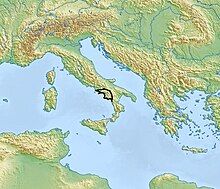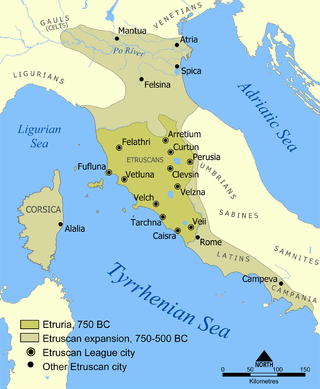
The Etruscan civilization was developed by a people of Etruria in ancient Italy with a common language and culture who formed a federation of city-states. After conquering adjacent lands, its territory covered, at its greatest extent, roughly what is now Tuscany, western Umbria, and northern Lazio, as well as what are now the Po Valley, Emilia-Romagna, south-eastern Lombardy, southern Veneto, and western Campania.

The European Neolithic is the period when Neolithic technology was present in Europe, roughly between 7000 BCE and c.2000–1700 BCE. The Neolithic overlaps the Mesolithic and Bronze Age periods in Europe as cultural changes moved from the southeast to northwest at about 1 km/year – this is called the Neolithic Expansion.

The Funnel(-neck-)beaker culture, in short TRB or TBK was an archaeological culture in north-central Europe. It developed as a technological merger of local neolithic and mesolithic techno-complexes between the lower Elbe and middle Vistula rivers. These predecessors were the Lengyel-influenced Stroke-ornamented ware culture (STK) groups/Late Lengyel and Baden-Boleráz in the southeast, Rössen groups in the southwest and the Ertebølle-Ellerbek groups in the north. The TRB introduced farming and husbandry as a major source of food to the pottery-using hunter-gatherers north of this line.
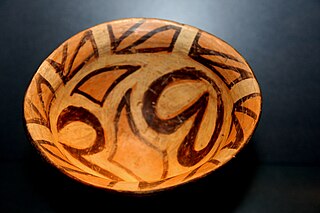
The Cucuteni–Trypillia culture, also known as the Tripolye culture, is a Neolithic–Chalcolithic archaeological culture of Eastern Europe.

The Vučedol culture flourished between 3000 and 2200 BCE, centered in Syrmia and eastern Slavonia on the right bank of the Danube river, but possibly spreading throughout the Pannonian plain and western Balkans and southward. It was thus contemporary with the Sumer period in Mesopotamia, the Early Dynastic period in Egypt and the earliest settlements of Troy. Archaeogenetics link the culture from Yamnaya migrations directly from the steppes that mixed with Neolithic people. The need for copper resulted in the expansion of the Vucedol Culture from its homeland of Slavonia into the broader region of central and southeastern Europe.
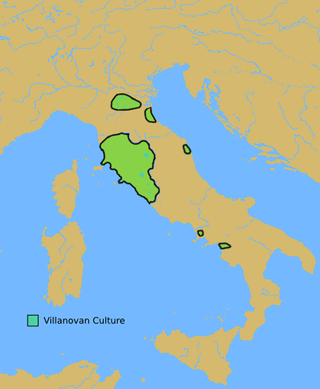
The Villanovan culture, regarded as the earliest phase of the Etruscan civilization, was the earliest Iron Age culture of Italy. It directly followed the Bronze Age Proto-Villanovan culture which branched off from the Urnfield culture of Central Europe. The name derives from the locality of Villanova, a fraction of the municipality of Castenaso in the Metropolitan City of Bologna where, between 1853 and 1855, Giovanni Gozzadini found the remains of a necropolis, bringing to light 193 tombs, of which there were 179 cremations and 14 inhumations.

The Italic peoples were an ethnolinguistic group identified by their use of Italic languages, a branch of the Indo-European language family.

The Sredny Stog culture is a pre-Kurgan archaeological culture from the 5th millennium BC. It is named after the Russian term for the Dnieper river islet of today's Seredny Stih, Ukraine, where it was first located.
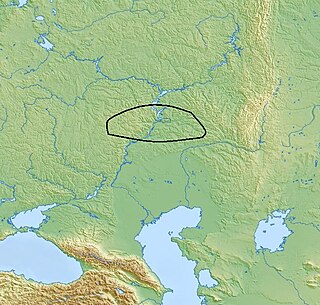
The Khvalynsk culture was a Middle Copper Age ("Eneolithic") culture of the middle Volga region. It takes its name from Khvalynsk in Saratov Oblast. The Khvalynsk culture extended from the Samara Bend in the north to the North Caucasus in the south, from the Sea of Azov in the west to the Ural River in the east. It was preceded by the Early Eneolithic Samara culture, from which it came, and succeeded by the Late Eneolithic, Early Yamna culture, into which it developed.

The Dnieper–Donets culture was a Mesolithic and later Neolithic culture which flourished north of the Black Sea ca. 5000-4200 BC. It has many parallels with the Samara culture, and was succeeded by the Sredny Stog culture.

The Varna Necropolis, or Varna Cemetery, is a burial site in the western industrial zone of Varna, internationally considered one of the key archaeological sites in world prehistory. The oldest gold treasure and jewelry in the world, dating from 4,600 BC to 4,200 BC, was discovered at the site. Several prehistoric Bulgarian finds are considered no less old – the golden treasures of Hotnitsa, Durankulak, artifacts from the Kurgan settlement of Yunatsite near Pazardzhik, the golden treasure Sakar, as well as beads and gold jewelry found in the Kurgan settlement of Provadia – Solnitsata. However, Varna gold is most often called the oldest since this treasure is the largest and most diverse.

Pontecagnano Faiano is a town and comune of the province of Salerno in the Campania region of south-west Italy. The area dates back to Roman times when the city of Picentia stood in the place and was destroyed by the Romans after the Second Punic War.
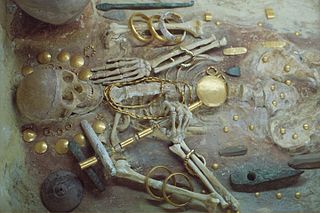
The Varna culture is a Chalcolithic culture of northeastern Bulgaria, dated ca. 4500 BC, contemporary and closely related with Gumelnița in southern Romania, often considered as local variants.

The prehistory of Italy began in the Paleolithic period, when species of Homo colonized the Italian territory for the first time, and ended in the Iron Age, when the first written records appeared in Italy.

In antiquity, several theses were elaborated on the origin of the Etruscans from the 5th century BC, when the Etruscan civilization had been already established for several centuries in its territories, that can be summarized into three main hypotheses. The first is the autochthonous development in situ out of the Villanovan culture, as claimed by the Greek historian Dionysius of Halicarnassus who described the Etruscans as indigenous people who had always lived in Etruria. The second is a migration from the Aegean sea, as claimed by two Greek historians: Herodotus, who described them as a group of immigrants from Lydia in Anatolia, and Hellanicus of Lesbos who claimed that the Tyrrhenians were the Pelasgians originally from Thessaly, Greece, who entered Italy at the head of the Adriatic sea. The third hypotheses was reported by Livy and Pliny the Elder, and puts the Etruscans in the context of the Rhaetian people to the north and other populations living in the Alps. The first Greek author to mention the Etruscans, whom the Ancient Greeks called Tyrrhenians, was the 8th-century BC poet Hesiod, in his work, the Theogony. He mentioned them as residing in central Italy alongside the Latins. The 7th-century BC Homeric Hymn to Dionysus referred to them as pirates. Unlike later Greek authors, such as Herodotus and Hellanicus, these earlier Greek authors did not suggest that Etruscans had migrated to Italy from elsewhere.
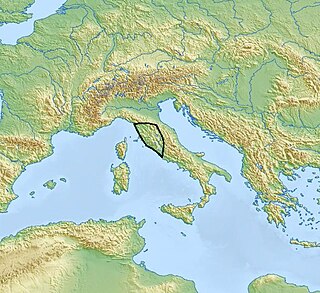
The Rinaldone culture was an Eneolithic culture that spread between the 4th and the 3rd millennium BC in northern and central Lazio, in southern Tuscany and, to a lesser extent, also in Marche and Umbria. It takes its name from the town of Rinaldone, near Montefiascone in the province of Viterbo, northern Lazio.
The Laterza culture or Laterza-Cellino San Marco culture is an Eneolithic culture in Southern Italy. It takes its name from the tombs discovered in the locality of Laterza, near Taranto, and Cellino San Marco, near Brindisi, in Apulia. It developed in Apulia and Basilicata, and to a lesser extent of Central Italy in the 3rd millennium BC, around 2950-2350 BC. As with many of the cultures of the late prehistoric period, it is known essentially from the style of pottery recovered from archaeological digs. The culture was defined in 1967 by Francesco Biancofiore, following research in a necropolis of the same name situated to the north-west of the city of Taranto, in southern Apulia.
Early European Farmers (EEF), First European Farmers (FEF), Neolithic European Farmers, Ancient Aegean Farmers, or Anatolian Neolithic Farmers (ANF) are names used to describe a distinct group of early Neolithic farmers who brought agriculture to Europe. Although the spread of agriculture from the Middle East to Europe has long been recognised through archaeology, it is only recent advances in archaeogenetics that have confirmed that this spread was strongly correlated with a migration of these farmers, and was not just a cultural exchange.

The Pontecagnano National Archaeological Museum is a museum in Pontecagnano Faiano, in the province of Salerno, Italy that opened in 2007. Since December 2014, the museum has been managed by the Campania Museum Complex.

In archaeogenetics, the term Western Steppe Herders (WSH), or Western Steppe Pastoralists, is the name given to a distinct ancestral component first identified in individuals from the Eneolithic steppe around the turn of the 5th millennium BCE, subsequently detected in several genetically similar or directly related ancient populations including the Khvalynsk, Sredny Stog, and Yamnaya cultures, and found in substantial levels in contemporary European and South Asian populations. This ancestry is often referred to as Yamnaya Ancestry, Yamnaya-Related Ancestry, Steppe Ancestry or Steppe-Related Ancestry.
